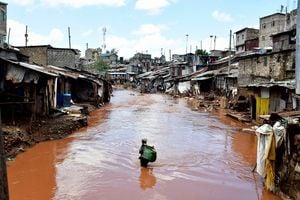Charities offer hope of better times for the vision impaired

Thomas Tembo Mwangome, a beneficiary of the white cane project.
What you need to know:
- Tom Mwangome from Kilifi County is just one of many beneficiaries of the White C(r)ane Project.
- Mwangome foresees this chance opening more doors not only for him, but for other visually impaired people.
- The mandate of the Kenya Society for the Blind is to promote the welfare, education, training and employment of the blind.
In 2007, Manish Shah was taking a hike in Taita Taveta County with a group of doctors who had visited Kenya to carry out free medical camps. As they passed by one of the homesteads that dot the Taita Hills region, they saw a young girl chained next to a hut.
Taken aback, they went into the homestead to find out why the child was tied up like that. Her mother explained that the girl was visually impaired and she feared that, if she wondered off, she might get lost or be attacked by wild animals.
Touched, the doctors, who had been performing free cataract operations in the country for years, asked the girl’s mother whether they could take her with them to Nairobi to have her eyes checked. The mother agreed.
They took her to Lions Sight First Eye Hospital in Loresho for a year’s treatment, after which she regained her sight. That young girl, says Dr Shah, is 16 years old now and is in Class Eight.
M A Math Charitable Trust Kenya, which Dr Shah is chairman and trustee, pays for her education and also supports her mother back in Taita Taveta.
According to the World Health Organisation (WHO), at least a billion people globally have a near or distance vision impairment that could have been prevented or has yet to be addressed, while The International Agency for the Prevention of Blindness says that three out of four cases of vision impairment could have been avoided. As the world marks World Sight Day today, Dr Shah looks forward to the day he can tell many such stories.
White canes
Tom Mwangome from Kilifi County is just one of many beneficiaries of the White C(r)ane Project, an initiative of Ayudh Kenya, an organisation formed in 2009 which has been providing needy young blind people in Kenya with white canes and which is under the wing of M A Math Charitable Trust Kenya.
He lost his sight when he turned two. Growing up without sight, he says, was challenging because he could not do most of the things that his peers did. His parents were supportive and enrolled him in school when he was old enough to join.
“I joined Likoni School for the Blind for my primary school education before joining Thika High School for the Blind. It is at these two institutions that I discovered myself and what I wanted to do with my life,” says Mr Mwangome, a musician and performer.
His specialty is the piano, even though he is conversant with other instruments such as the drums, flute and the guitar.
“My repertoire is vast. I perform jazz, dance music, zilizopendwa — just about any kind of music,” he explains. Through the support of the M A Math Charitable Trust Kenya, he, together with the organisation’s Goodwill Ambassador, Tanya Martin, have recorded a song, titled, ‘See Through My World’ which talks about how blind people go about their day and how they would want others to view them and support them. The song will be launched this month.
Mwangome foresees this chance opening more doors not only for him, but for other visually impaired people.
“This song will reach more people than my live performances have and will inspire other visually impaired people that they too can pursue their dreams and succeed.”
According to Solomon Bukhala, Director of the Kenya Society for the Blind, there are approximately 500,000 vision impaired individuals in Kenya, out of these, 45,000 are children not enrolled in school while 3,000 are currently in school.
Challenges
The mandate of the Kenya Society for the Blind is to promote the welfare, education, training and employment of the blind and to assist in the prevention and alleviation of blindness. It is an important responsibility, but one hampered by various challenges, the biggest one being resources.
“Though we are formed by an act of parliament, we are not funded by the exchequer, therefore it is up to us, with some help from the government, to look for the money needed to fulfil our mandate,” says Mr Bukhala, who singles out donor fatigue as the second biggest challenge they face, bearing in mind that the society was established in 1956 and has been extending the begging bowl for quite a while now. This partnership with White C(r)ane Project and Ayudh Kenya could not have come at a better time.
“The biggest need for the visually impaired is inclusivity; they should access appropriate education, appropriate devices that makes their lives easier, access to employment and enhancing their skills. We want to teach them how to fish, so that they can eat that fish whenever they want,” says Mr Bukhala.
The organisation is doing this are doing this through funding from the M A Math Charitable Trust Kenya in partnership with others. One of them is a programme carried out by Shiatsu Physiotherapy Clinic, which has been training the vision impaired in Kenya to become masseurs; 40 have graduated so far.





